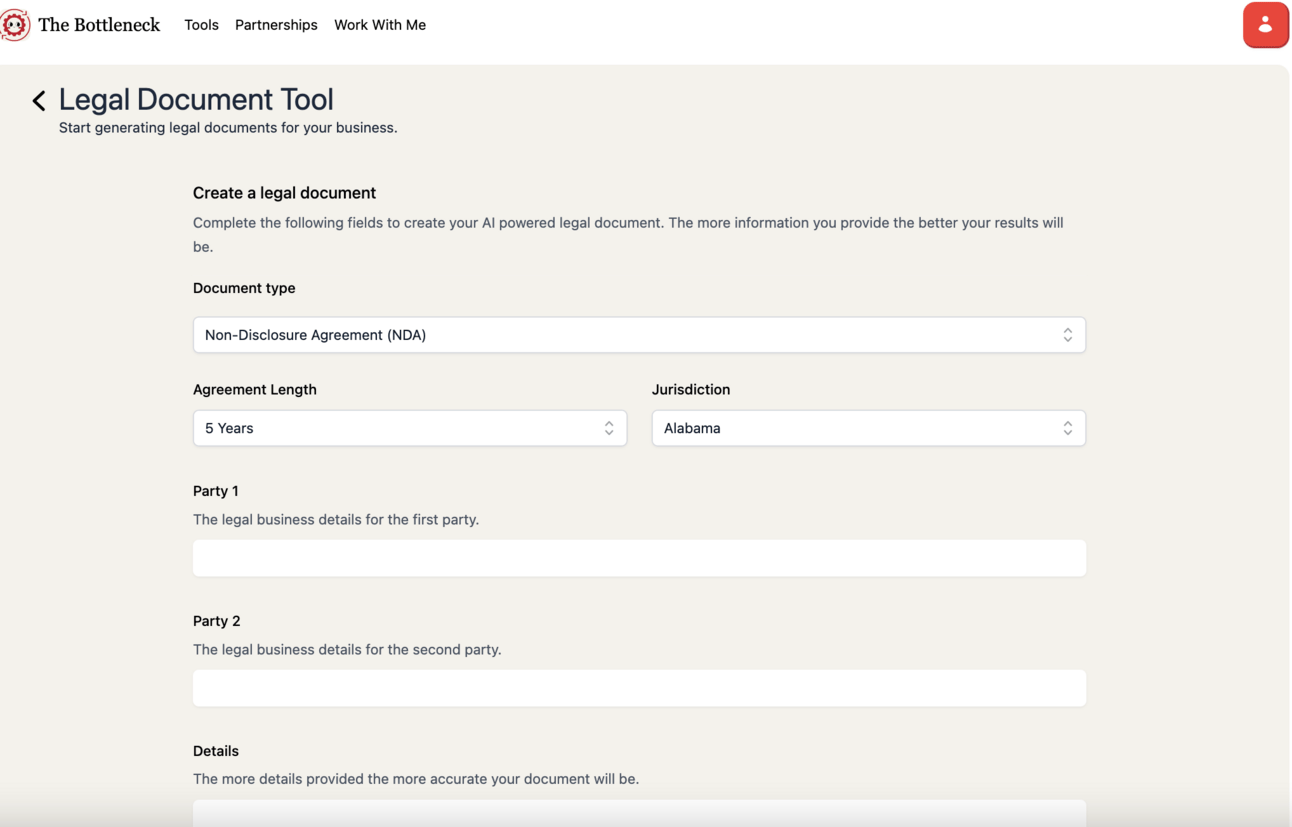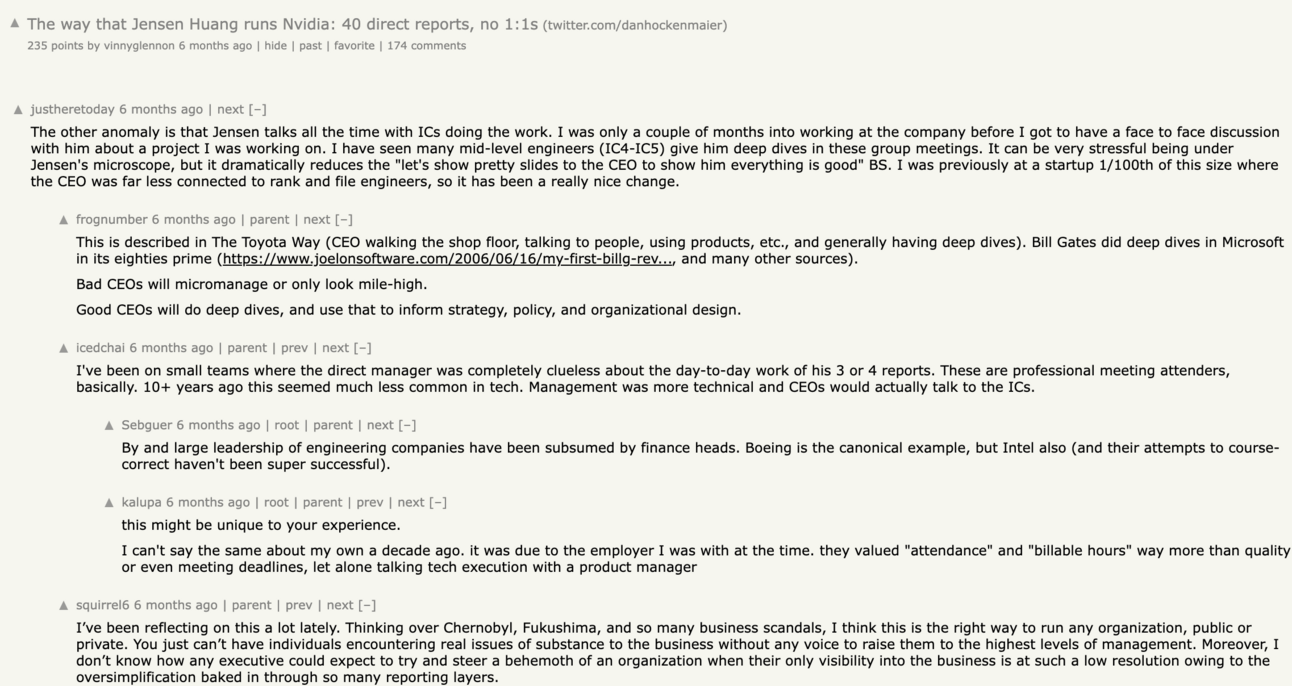
👋 Hi, welcome to a free preview of 🔒 paid-member edition 🔒 of The Bottleneck.
Each week, I tackle questions about scaling operations, driving efficiencies, and accelerating your career to 20,000+ COOs and startup operators.

Read Time: 7.8 Minutes
Happy Sunday Operators ⚙️
Tool #2 just launched!
We released our legal document AI generator in The Bottleneck+ membership.
Now, you can autogenerate legal documents like NDAs and employee contracts in one simple place.
Keep an eye out as we launch tool #3 later this month.
Check out the tool when you get the chance.

Setting the Stage
How Nvidia built speed into the culture
I worship at the altar of speed.
The quicker I move, the better I feel.
I bet Nvidia’s CEO, Jensen Huang, agrees with me.
In 1993, Jensen Huang and two buddies hatched Nvidia's plan over a plate of food at Denny's.
Fast forward to today, and Huang has steered Nvidia from a gaming graphics card gem to an AI titan.
With the recent rally in Nvidia stock, the company has a realistic chance of becoming the biggest U.S. company.
Jensen Huang pivoted to AI in 2013. A decade later, that bet has paid off 250-fold.
(Literally, the stock price was at $3 in 2013. Now, it’s hovering at $870.)
Nvidia is the classic example of a shovel seller in a gold rush.
One Wall Street Analyst said it perfectly:
There’s a war going on out there in A.I., and Nvidia is the only arms dealer
So, how has Jensen built such a massive empire?
I would credit Jensen's emphasis on pursuing all "real ground truths."
When Jensen first created his organization, he reverse-engineered what he needed to succeed.
By examining the industry he was pursuing, he boiled his needs down to 3 factors:
He was attempting to build products that the world has never seen. He needed the world's best talent
Within a burgeoning industry, any technology update could disrupt a well-thought-out plan. He needed to be able to pivot as new information came in.
Build a flat hierarchy so those on the ground could flow information to the top
Jensen’s company success is built on getting to the ground truth.
The people “in the mess” will know how to solve problems the best.
Ops Tactic: Get the “ground truth” to the top of the organization. With real non-biased information traveling fast, companies can pivot quickly.

Why this Matters
Ground truths point you in the right direction
What makes a great manager?
Part of being a great manager is developing expertise in your area, which is why the best managers are often elite ICs in a domain.
But the most fundamental job of a manager is to have good judgement. And perhaps the most important ingredient of good judgment is having as much context as possible.
What actually makes this business tick?
What are we really trying to accomplish?
How are other teams trying to accomplish it?
And most importantly, what is actually happening at the company, on the ground, right now?
Huang always asks employees to consider “the speed of light.”
This means employees should consider the absolute fastest a task could conceivably be accomplished, then work backward toward an achievable goal.
This priority for speed causes teams to want to be on the same page at all times.
Huang said it best,
"Our company just performs better because everybody's aligned, everybody is informed of what's going on”
His goal is to amass a treasure trove of context that fuels his decision-making.
Jensen Huang is perhaps the greatest context sponge of all time.

The Blueprint
Jensen has created an organizational structure that is... unique.
Try these 3 tactics to get information spread around your organization quickly.
Top 5 Things
Jensen has an approach he calls “stochastically sampling the system.”
He says,
“I don't read any status reports. And the reason I don't is because status reports are meta-information by the time you get them. They are barely informative. They have been distilled and refined and bias has been inserted, perspective has already been added and you're not looking at ground truth anymore."
Instead of asking for status updates, anyone in the company can email him a list of the “top five things" on their mind.
If you send a list out to him, Jensen will read it.
He estimates that he reads 100 of these every day.
Because Nvidia does not have annual planning sessions, “Top Five Things” appear to be an informal version of OKRs.
This style allows for real-time checks on the state of the organization.
Hire elite talent to empower your team
Jensen’s guiding principle at NVIDIA is to keep the company as small as possible.
This naturally requires him to empower people, which in turn necessitates having a flat org structure.
Jensen has ~40 direct reports, highly unusual for a public company CEO. He does not have regularly scheduled 1:1s with any of his staff.
Because he is bringing the best in the world into his organization, they don’t need to be coached. (AKA 1v1s aren't necessary).
As a leader of an organization, are you going to pull off no 1v1's?
I doubt it.
But, you can work on recruiting elite talent you don't need to handhold.
Publicly share failures
Perhaps Huang’s most radical belief is that “failure must be shared.”
Instead of firing the card’s product managers, Huang arranged a meeting in which the managers presented every decision they had made to a few hundred people.
Nvidia also distributed to the press a satirical video starring the product managers, in which the card was repurposed as a leaf blower.
Presenting one’s failures to an audience has become a beloved ritual at Nvidia.
So how can you imitate this?
After every launch, there is usually a product post-mortem for technical teams.
Why not include everyone in that meeting?
In this post-mortem, share the statistics and expectations for the launch.
Did you meet them?
You should have your teams explain where they failed and succeeded to everyone else.

Explore Further
The Two Paths of Manager
Jensen is a great example of how to avoid hiring Macromanagers. Macromanagers are people who give too little direction to their team to the point of undermining their performance.
A 90-minute interview between the hosts from Acquired and Jensen
Here is the infamous interview where Jensen stated that if he could go back in time and build Nvidia all over again, he would not do it.
Hacker News reacting to Jensen stating he has 40 direct reports
Gotta love the amount of stories in here from current and former employees at Nvidia.

Spread The Word
Share The Bottleneck with friends to get a few freebies. Maybe you’ll make some new friends along the way 😆
We’ll give you free stuff and more friends if you share a link. Only one link.

{{rp_personalized_text}}





